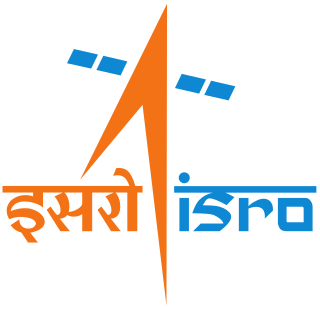
Indian Space Research Organisation is India's national space agency. It serves as the principal research and development arm of the Department of Space (DoS), overseen by the Prime Minister of India, with the Chairman of ISRO also serving as the chief executive of the DoS. It is primarily responsible for space-based operations, space exploration, international space cooperation and the development of related technologies. The agency maintains a constellation of imaging, communication and remote sensing satellites. It operates the GAGAN and IRNSS satellite navigation systems. It has sent three missions to the Moon and one mission to Mars.

The Indian Regional Navigation Satellite System (IRNSS), with an operational name of NavIC, is an autonomous regional satellite navigation system that provides accurate real-time positioning and timing services. It covers India and a region extending 1,500 km (930 mi) around it, with plans for further extension up to 3,000 km (1,900 mi). An extended service area lies between the primary service area and a rectangle area enclosed by the 30th parallel south to the 50th parallel north and the 30th meridian east to the 130th meridian east, 1,500–6,000 km (930–3,730 mi) beyond borders where some of the NavIC satellites are visible but the position is not always computable with assured accuracy. The system currently consists of a constellation of eight satellites, with two additional satellites on ground as stand-by.
The Integrated Space Cell was the nodal agency within the Government of India with oversight of the security of its space based military and civilian hardware systems. It was to be jointly operated by all the three services of the Indian Armed Forces, the civilian Defence Research and Development Organisation and the Indian Space Research Organisation (ISRO). This agency was superseded by Defence Space Agency in 2019.[better source needed]

RISAT (Radar Imaging Satellite) is a series of Indian radar imaging reconnaissance satellites built by the Indian Space Research Organization (ISRO). They provide all-weather surveillance using synthetic aperture radars (SAR).
RISAT-2, or Radar Imaging Satellite-2 was an Indian radar imaging reconnaissance satellite that was part of India's RISAT programme. It was built by Indian Space Research Organisation (ISRO) and successfully launched aboard a PSLV-CA launch vehicle at 01:15:00 UTC on 20 April 2009 from the Second Launch Pad at the Satish Dhawan Space Centre.

The NASA-ISRO Synthetic Aperture Radar (NISAR) mission is a joint project between NASA and ISRO to co-develop and launch a dual-frequency synthetic aperture radar on an Earth observation satellite in 2025. The satellite will be the first radar imaging satellite to use dual frequencies. It will be used for remote sensing, to observe and understand natural processes on Earth. For example, its left-facing instruments will study the Antarctic cryosphere. With a total cost estimated at US$1.5 billion, NISAR is likely to be the world's most expensive Earth-imaging satellite.

Tapan Misra is an Indian scientist who has been the Director of Space Applications Centre and Physical Research Laboratory in ISRO. He later became Senior Advisor to the Chairman, ISRO.

Dhruva Space Private Limited is an Indian private aerospace manufacturer headquartered in Hyderabad, Telangana. Founded in 2012 by Sanjay Srikanth Nekkanti, the company is engaged in the development of small satellites in the commercial, governmental and academic markets. It provides full-stack space-engineering solutions across launch, space and ground segments – namely, the building, launching and operation of satellites.

The Small Satellite Launch Vehicle (SSLV) is a small-lift launch vehicle developed by ISRO to deliver 500 kg (1,100 lb) payload to low Earth orbit or 300 kg (660 lb) payload to Sun-synchronous orbit. The rocket supports multi-orbital drop-offs capability for small satellites.

PSLV-C42 was the 44th mission of the Indian Polar Satellite Launch Vehicle (PSLV) program and its 12th mission in the Core Alone (CA) configuration. PSLV-C42 successfully carried and deployed 2 Earth observation satellites in Sun-synchronous orbits at an altitude of 588 kilometres (365 mi). It was launched on 16 September 2018 by the Indian Space Research Organisation (ISRO) from the first launch pad of the Satish Dhawan Space Centre at Sriharikota, Andhra Pradesh. The two international satellites were launched as part of a commercial arrangement between Surrey Satellite Technology Limited (SSTL) and ISRO's commercial arm Antrix Corporation Limited, run under the auspices of the Indian Government's Department of Space.
The Human Space Flight Centre (HSFC) is a body under the Indian Space Research Organisation (ISRO) to coordinate the Indian Human Spaceflight Programme. The agency will be responsible for implementation of the Gaganyaan project. The first crewed flight is planned for 2024 on a home-grown LVM3 rocket.

The X-ray Polarimeter Satellite (XPoSat) is an Indian Space Research Organisation (ISRO) manufactured space observatory to study polarisation of cosmic X-rays. It was launched on 1 January 2024 on a PSLV rocket, and it has an expected operational lifespan of at least five years.

NewSpace India Limited (NSIL) is a Public Sector Undertaking (PSU) of the Government of India and under Department of Space. NSIL is responsible for producing, assembling and integrating the launch vehicle with the help of industry consortium. It was established on 6 March 2019 under the administrative control of the Department of Space (DoS) and the Company Act 2013. The main objective of NSIL is to scale up private sector participation in Indian space programmes.
RISAT-2B, or Radar Imaging Satellite-2B is an Indian radar reconnaissance satellite that is part of India's RISAT programme and the third satellite in the series. It is built by Indian Space Research Organisation (ISRO) to replace RISAT-2.

Pixxel (pik·sl) is an Indian-American private space technology company building a constellation of the world's highest-resolution hyperspectral imaging satellites into a sun-synchronous orbit along with Aurora, its in-house Earth observation platform designed to convert satellite imagery into actionable insights.

Skyroot Aerospace Private Limited is an Indian private aerospace manufacturer and commercial launch service provider headquartered in Hyderabad, Telangana. The company was founded by former engineers and scientists from ISRO. It aims to develop and launch its own series of small-lift launch vehicles especially crafted for the small satellite market.

AgniKul Cosmos Private Limited is an Indian aerospace manufacturer based in National Centre for Combustion Research and Development (NCCRD) of IIT Madras, Chennai. The start up aims to develop and launch its own small-lift launch vehicle such as the Agnibaan, capable of placing 100 kg (220 lb) payload into a 700 km (430 mi) orbit. The first commercial launch was expected in 2022. However, no launch happened in that year. The first suborbital mission will be conducted on 22 March 2024. This did not happen either. The company tried twice to launch its suborbital rocket in March and April but postponed due to technical issues.
Centum Electronics Limited is an Indian electronics system design and manufacturing company. The company produces subsystems and microelectronics, and provides system integration services. The company was incorporated in January 1993 and is headquartered in Bangalore, Karnataka. Centum has a presence in 6 countries. It has manufacturing facilities, design, and sales and support teams in India, Canada, and France, a design team in Belgium, and sales and support teams in the United Kingdom and the United States. The company's British subsidiary, Centum Electronics UK Ltd., services all European customers except those in France.

Nilesh M. Desai is an Indian engineer and a space scientist known for his contributions in the field of space technology and applications. His contributions span across multiple Indian space programs, notably in the development of microwave radar satellites, the Indian Regional Navigation Satellite System (NAVIC), quantum key distribution, and spearheading the third Indian lunar exploration mission, Chandrayaan-3. He assumed the directorship of the Space Applications Centre (SAC), Ahmedabad, on January 1, 2021.

The PSLV C-58 was the 60th flight of the Indian Space Research Organisation's Polar Satellite launch Vehicle. It carried the XPoSAT mission along with rideshare payloads.




















